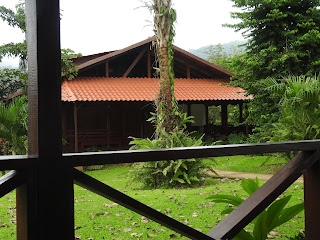The Costa Rican peoples' way of life is so full of kindness and compassion. Everyone we met treated us as though they had known us for years. The food, people, and culture was so vibrant. Anywhere outside, wherever you step is teeming with life. During our excursions, we encountered an amazing amount of wildlife. As many of you are probably aware, the trip began in Finca la Anita, a cacao farm where we conducted research concerning leaf cutter ants or butterfly caterpillars. The farm was amazing, and the chocolate was even better! During the night hikes and other excursions, I encountered many of the creatures I had on my "list". At Anita, I personally saw two ring necked coffee snakes (Ninia diademata), a blunt head snake (Imantodes cenchoa), a probable, but unconfirmed, narrow bridged musk turtle (Claudius angustatus), and a very nice turnip-tailed gecko (Thecadactylus rapicauda). Surprisingly, I also spotted a very large male green basilisk (Basiliscus plumifrons) very far out of its range. We also encountered many species of other insects, various frogs/toads (Most commonly cane toads (Rhinella marina) and leaf litter toads (Rhaebo haematiticus)), and geckos/lizards.
During our stay, we also visited a national park. We spotted various birds and small arboreal lizards in the canopy. As is so often the case with "herping" (the searching for reptiles and amphibians), one finds the most fascinating specimens only if two things are true: (1) you are horribly ill prepared and (2) you are extremely slow to the point of perceived insanity. This is how my hunt for the peanut-headed bug began (Fulgora laternaria). This bug is a species that has been on my "list" since I first heard of this trip. It is a bizarre and unfortunately understudied genus that is both fascinating historically and in modern day. The natives of Costa Rica hold many interesting stories about the large insect. Before our trip to the park began, my camera died while I was photographing comparatively insignificant birds. This completed step one. We then arrived, we hiked, and I went very slowly (step 2 complete). I was actually later told by Russel that I should not be so slow next time, because the jaguars might think I had a broken leg. Luckily, I was not eaten, and survived to see a peanut-headed bug! I don't think it found me to be quite as amazing as I found it to be (it defecated all over me). Foot note: I later found another species that had a red spiked crown on the end of its "peanut", later identified as a separate genus: Pterygota quinquepartitus.
As well as the rich rain forest, we visited the vast dry forest. At the conclusion of the trip, we left to visit another research station near the beach. Within the hour, I had found an anulated cat eye snake (Leptodeira annulata), multiple spiny-tail iguanas (Ctenosaura pectinata), and a very large managua skink (Mesoscincus managuae). I later heard of a baby red tail boa (Boa constrictor) and Costa Rican indigo snake (Unicolor cribo), both of which had slithered away by the time I arrived on scene. Our first night at the station, we left in the hopes of finding a sea turtle. After hours of scanning the beach without light, the radio crackled with the news of a nesting turtle. In groups of four we left to visit the nesting Olive Ridley sea turtle (Lepidochelys olivacea). She first made a tiny rut in the ground, then began to make a hollow chamber in the packed sand. Upon the conclusion of this task, she began to drop ping-pong ball sized eggs into the cavity. Once complete, the nest was covered and all dry sand was returned in a careful fashion by the mother turtle. She then returned to the sea, having taken only about an hour on land. The entire process was amazing and extremely rare this time of year. We had all but completed accepted that we would stay up all night for no turtles, so the sight was even cooler given the rarity. The amount of amazing biodiversity in this country simply cannot be stated enough.
For me, and I'm sure the rest of my peers, the Costa Rica trip was unbelievable. For such a small country, Costa Rica is perhaps one of the coolest places I have ever visited. It has coasts, rain forests, plains, volcanoes, dry forests, plains, and more. Only here can you find cacti washing up on the beach during a tropical rainstorm with thermal vents on the horizon (which happened).
* Scientific names are written to avoid confusion, as many of my guide books had very contradicting common names.
Pura Vida!
Greyson Offermann






































